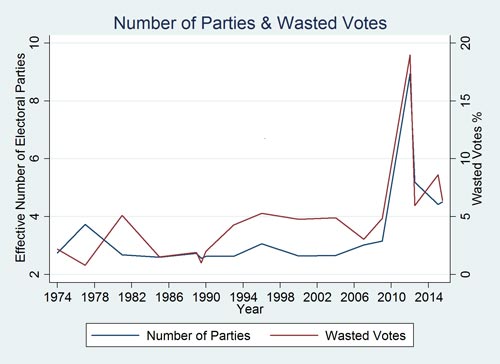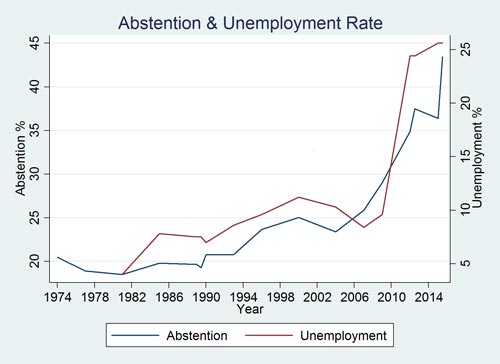The Greek party system: Out with the old, in with the new?

Greece has been attracting enormous attention in recent years due to its frail economic situation and the diverging opinions as to how to deal with it. Massive public debt, a failing banking system, and a collapsing labor market are among the issues most analyses focus upon. However, relatively less attention has been paid to the Greek party system and how it has been affected by the financial crisis.
Comparing the party system before and after the crisis, one is struck by the dramatic changes Greek politics has gone (and is still going) through. It is crucial to map out these changes and try to understand the factors causing them; any potential solution to the crisis will depend upon the ability of the party system to propose and push through the necessary economic and social reforms.
Some background information is necessary in order to comprehend the seismic changes Greek politics is going through. After the re-establishment of democratic politics in 1974, Greece enjoyed a stable two-party system, dominated by strong single-party governments (with a brief exception in 1989 due to a very proportional electoral system). Alternation in power oscillated between the socialist PASOK and the conservative New Democracy, with smaller parties playing a marginal role in governmental politics. Greece could easily serve as an exception to Duverger’s Law, since its so-called “reinforced PR” regularly produced a two-party system where the need for compromise and coalition politics was almost nonexistent.
Yet this party system quickly dissipated with the beginning of the crisis. The facts are startling: Since 2009 there have been five national elections, all called early; the first referendum since 1974; eight prime ministers and four coalition governments. This is hardly the picture of an established party system; if anything, it resembles the experience of new democracies, going through a typically turbulent transitional period until their party systems settle down.
Looking at some data can be illuminating about the changes in Greek politics. Figure 1 depicts the effective number of parties, a standard measure in political science, weighing parties by their vote share.1 Beyond some early fluctuation, the number of parties (blue line) remains relatively stable around 2.5 until the late 2000s. However, party numbers skyrocketed to more than eight in the May 2012 elections, the first held after the implementation of the (first and second) bailout programs. This extreme fragmentation was unseen in Greek politics; PASOK and ND fell to historic lows, combining to a loss of more than 45 percent. Simultaneously, SYRIZA became a main political player, almost quadrupling its vote share.
Figure 1.

In the same figure we can also see the percentage of wasted votes, those going to parties that do not achieve parliamentary representation. The similarity in trends with the number of parties is striking; wasted votes (red line) were quite stable before the crisis, hovering below 5 percent. In the first post-bailout elections of 2012 however, wasted votes climbed sharply to 19 percent, more than the vote share of the winning party. In the three elections since, wasted votes have been significantly higher than before 2009, as have the number of parties. These extreme changes are atypical in established party systems; they represent a watershed moment in Greek politics and mark the implosion of the party system.
Another key part of the puzzle of Greek politics demanding attention is the level of abstention. Experiencing a slow increase since the 90s, similar to that observed across most established democracies, abstention has gone through the roof since the crisis, exceeding 43 percent in the last election. Arguably, this is related to several factors: declining partisan identities, the reduced ability of parties to engage in patronage and public jobs disbursement (one of the preferred tools of building support), the perceived policy convergence of parties (especially following the collapse of the memorandum as a dividing line between parties), and voter fatigue. The determinants of abstention are important to understand, especially if one assumes that a non-negligible part of recent abstentees could potentially be mobilized again.
Figure 2 charts abstention rates and unemployment levels.2 While it is not easy to prove that abstention is causally linked to unemployment, the parallel trends are obvious and suggest a relationship between the two. Both abstention (blue line) and unemployment (red line) follow a slow upward trajectory throughout the period, but their sharp, almost identical, increase since 2009 is intriguing.
Arguably, this could be jointly caused by some other factor; nonetheless, it is a link worth investigating, alongside the dwindling levels of partisan identification. If abstention is, at least partially, caused by unemployment, this suggests that a potential improvement of the economic situation in Greece may help turnout rates to recover. However, unless economic recovery is speedy, the fear of chronic unemployment may also lead to chronic abstention.
Figure 2.

Summing up, the combination of a violent period of de- and re-alignment, high levels of fragmentation, increased wasted votes and high abstention creates a volatile party system. Coalition governments are likely to become the norm and parties will have to adjust their strategies, both pre- and post-electorally. The weakening ties between parties and citizens suggests that parties will have to work hard to regain the trust of voters. It can no longer be the case that they rely on patronage and public sector appointments to build support; they have to invest in fighting unemployment and abandon populism to become reliable. The Greek party system as we once knew it is no more, and it will take time before it consolidates again. One can only hope that regardless of how it will end up looking, it will not exhibit the characteristics of its pathological antecedent; otherwise, it is hard to imagine how it can steer the country out of the crisis it helped create.
1. The effective number of parties and wasted votes are based on the author’s calculations.
2. Unemployment data is taken from the European Union Labour Force Survey, while electoral data is reported from the Greek Ministry of Interior’s elections portal.
Nasos Roussias is a Lecturer at the Department of Politics at the University of Sheffield in the UK.





